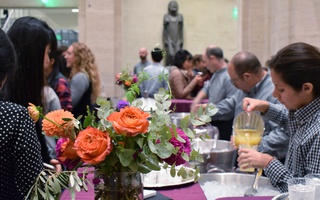{shortcode-7481cd3d2ad12a7f5b6623610f726af69ce4f91a}
The Harvard Art Museums have recently undergone a series of expansions, uniting their three buildings into a single facility and adding gallery space as well as classrooms and lecture halls. To celebrate the historical transformation of the buildings, on April 17, the museums opened a new installation, “Triangle Constellation,” by Mexican artist Carlos Amorales.
Suspended from the glass roof above Calderwood Courtyard, the specially-commissioned mobile sculpture connects 16 triangles with a flexible framework. According to Mary Schneider Enriquez, the Houghton associate curator of modern and contemporary art, it is the first artwork that visitors see upon entering the museum. This hopefully will lead them to look up and, through its steel skeleton, ponder upon the whole interior of the six-story building. Situated at the center of the building, the piece occupies a unique location that provided both challenges and inspiration for Amorales. “[The museums] use the courtyard as a space that’s public, so all things happen here,” he says. “It’s not an exhibition gallery, but where people walk through, so this brings a very specific challenge.”
“Triangle Constellation” was created by Amorales to resonate with the character of the Harvard Art Museums. The graduated scale of the triangle, for example, symbolizes the expansion of the museums. “One inspiration I’ve been thinking about is the tornado,” Amorales says. “It is something that moves and spins, growing up, so it really has the sense of expansion.”
{shortcode-1f6b7d15caf7579d1cf1852b48584987f831f524}
Amidst the Harvard Art Museums’ rich collection of more traditional works, “Triangle Constellation” shows the museums’ hope to make more contemporary works and artworks of more diverse forms accessible to visitors. “We are an institution of very strong historical collection, whether it’s Egypt or Ancient European or Impressionist,” Schneider Enriquez says. “Our contemporary collection has been slower to build. We are broadening and growing that collection, and [Amorales’s] piece really fits into the direction we’re taking.”
The museums curators first considered creating an installment on the ground, but since the Calderwood Courtyard is a busy, active area, they decided that they wanted a work that could be hung from the ceiling. It took Amorales almost two years to create a piece that suits this environment, and Schneider Enriquez describes the result as a simple and extremely organic form. “You have to see it well, to see it in different ways. It looks different everywhere,” she says. “The whole black structure is literally like the veritable of a fish. Not only does it appear this way, but it [also] moves and flows in this space. It draws us from here [the ground] way up to the cross space.”
{shortcode-51fbb7cc530e0b7672535629de34cfef0701d236}
According to Enriquez, other aspects about the location were also considered, including the natural light that comes through the glass roof and the locations of the two entrances on each side of the sculpture. Amorales also made his work more physically interactive by using an orchestra triangle as the smallest triangle in the installation. “You could play that triangle and make sounds from that triangle,” Amorales says. In this sense, the sculpture becomes a work that is not only visual but also potentially acoustic.
As a new addition to the Harvard Art Museums’ renovations, “Triangle Constellation” will be on display for several years after its inauguration, and the museums hope that it will complement the diverse works of art visible in the courtyard and those in the collections. “I’m thrilled [by the addition of this work],” Schneider Enriquez says. “I think throughout the museums everyone is very excited about it.”
—Staff writer Tianxing V. Lan can be reached at tianxing.lan@thecrimson.com.
Read more in Arts
Artist Spotlight: Tania LeónRecommended Articles
-
Forging a Public TrustWith funding for cultural institutions on the decline, the question of the role of museums in preserving the artifacts of
-
Review of "After Hours at the Harvard Art Museums"
-
Art Museums Launch Fellowship, Summer Institute Through DonationsThe Harvard Art Museums received over $1.5 million in donations this month for a new fellowship and summer program.
-
 After Hours at the Museums: Color, Cocktails, Celebration
After Hours at the Museums: Color, Cocktails, Celebration -
 Harvard Art Museums' Study Center Showcases Warhol Collection
Harvard Art Museums' Study Center Showcases Warhol Collection













